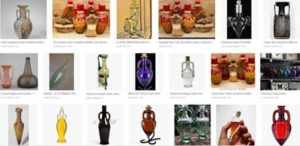Sometimes cases are not really that interesting for their outcome, but rather for how the Courts get there. In this case, Wajos GmbH filed a 3D mark consisting of a glass container, shown below, designating various goods in classes 29, 30, 32 and 33.
The EUIPO’s examination division and Board of Appeal (BOA) held that the mark was a mere combination of non-distinctive components not differing from other amphora-like containers available on the market and consequently it was not eligible for registration.
Wajos filed an appeal and the General Court (GC) reversed, holding that the BOA had assessed the (lack of) distinctive character of the mark on the basis of an erroneous perception of the characteristics and nature of the trademark applied for.
While it is not uncommon that the GC substitutes its own factual assessment for that of the EUIPO – not only in ex parte proceedings, but also on inter partes proceedings such as oppositions, this should always happen upon a re-evaluation under the known standard of the average consumer who is reasonably well informed, observant and circumspect, in light of facts and evidence proffered by the parties and/or on matters of common knowledge.
It is known that under settled EU case-law, a 3D mark is distinctive when its shape differs significantly from usual shapes commonly available in the market, in a way that it enables consumers to identify the commercial origin of the goods just by their shape or by their packaging. And the EU case-law places the burden of proof on the side of the applicant to prove this “unusualness”, because the average consumer is reasonably well informed, observant and circumspect, but not really an expert of in any particular field (like the mythical “informed user” proper to Design laws).
Still, based on the same evidence already filed earlier (Wajos had filed additional evidence but the GC held such evidence inadmissible because it was submitted for the first time before it), the GC simply revisited the findings by the BOA and decided that the combination of the elements constituting the mark applied for gave the container in question a particular appearance “as consumers are not used to containers with a significantly curved shape in their middle” (at §34).
In addition, the GC added a “moreover”, (to give some “appearance” of foundation to its conclusion?): “the image evoked by the trade mark applied for differs from that of traditional amphorae, contrary to the BOA’s conclusion in paragraph 26 of the contested decision, in particular in view of the fact that such amphorae are not normally made of glass.” (cf. at §34)
Based on which evidence did the GC find that consumers are not used to containers with a significantly curved shape in their middle is a mystery, as it is a mystery where the GC found evidence supporting its conclusion that “amphora-like containers are not normally made of glass”.
Was the GC thus stating a matter of “common knowledge” that is, something likely to be known by anyone or which may be learnt from generally accessible sources, without evidence being required in that regard? This is unclear, because if it was, why did the GC not admit the additional evidence filed by Wajos, given that an applicant is entitled to produce documents before the Court as evidence of the accuracy of a matter of common knowledge, which was not established in the decision of the EUIPO contested before the Court (see, to that effect, case T-357/10)?
Moreover, compare this case with the recent case T-261/17, where the GC, while recognizing that the BOA may take into consideration facts which are well known, still recognized the necessity to have some evidence to support a conclusion. Indeed in such case the GC, which agreed with the BOA’s assertion that a certain fact was well known, stressed that it “was supported by numerous examples presented by the intervener in the context of the proceedings before EUIPO”, (cf. at §42). If it is thus so important for the BOA that its assertions are supported by evidence, shouldn’t this be even more so when the GC reverses the BOA on a factual matter?
Out of curiosity, since we are not real experts in the field, we launched a search for images of amphorae made of glass on a famous search engine and guess what? It turns out that glass amphorae are pretty common, since the Romans’ times….
_____________________________
To make sure you do not miss out on regular updates from the Kluwer Trademark Blog, please subscribe here.
Kluwer IP Law
The 2022 Future Ready Lawyer survey showed that 79% of lawyers think that the importance of legal technology will increase for next year. With Kluwer IP Law you can navigate the increasingly global practice of IP law with specialized, local and cross-border information and tools from every preferred location. Are you, as an IP professional, ready for the future?
Learn how Kluwer IP Law can support you.




